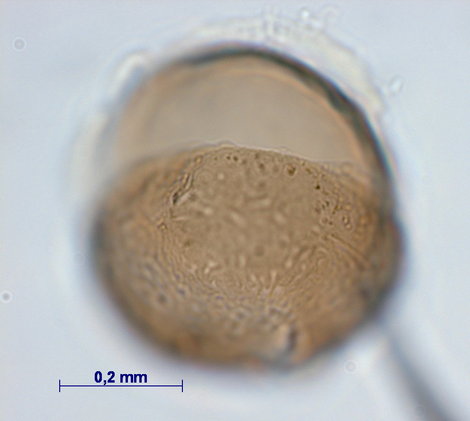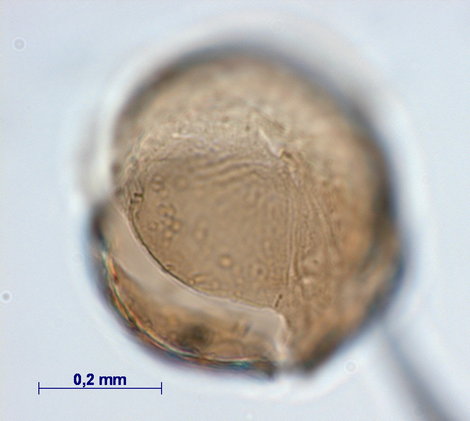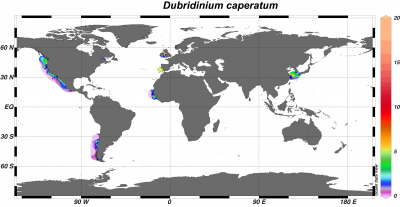Die Inhalte dieser Seite sind leider nicht auf Deutsch verfügbar.
Seitenpfad:
- Modern Dinocyst Key
- brown cysts
- round brown with septa, reticulation, double wall
- Cysts with paratabulation in form of septa
- Cyst of Dubridinium caperatum
Cyst of Dubridinium caperatum
Zonneveld, K.A.F. and Pospelova V. (2015). A determination key for modern dinoflagellate cysts. Palynology 39 (3), 387- 409.

antapical view
photograph Karin Zonneveld
photograph Karin Zonneveld

ventral/apical view
Field characteristics
Dubridinium caperatum Reid 1977
Field characteristics:
Cavate cyst of lenticular shape, with a pronounced polar compression and a slight dorso-ventral compression. The endophragm is relatively thick (1-2 µm) and microgranulate. The periphragm is thin, closely attached, and sometimes showing indications of tabulation in the form of ridges delimiting the cingulum and ventral sulcus.
Dimensions: Cyst body diameter: 40 to 42 (width) to 51 to 56 (length) µm.
Motile affinity: Preperidinium meunieri (Pavillard 1913) Elbrächter 1993
Cyst theca relationship: Wall and Dale, 1968
Stratigraphic range: Holocene.
Comparison with other species:
This species is easily recognisable by its reflected tabulation, having the archeopyle which give it an appearance like a „pack-man“, and the small intercalary plate that is often clearly reflected.
Field characteristics:
Cavate cyst of lenticular shape, with a pronounced polar compression and a slight dorso-ventral compression. The endophragm is relatively thick (1-2 µm) and microgranulate. The periphragm is thin, closely attached, and sometimes showing indications of tabulation in the form of ridges delimiting the cingulum and ventral sulcus.
Dimensions: Cyst body diameter: 40 to 42 (width) to 51 to 56 (length) µm.
Motile affinity: Preperidinium meunieri (Pavillard 1913) Elbrächter 1993
Cyst theca relationship: Wall and Dale, 1968
Stratigraphic range: Holocene.
Comparison with other species:
This species is easily recognisable by its reflected tabulation, having the archeopyle which give it an appearance like a „pack-man“, and the small intercalary plate that is often clearly reflected.
Geographic distribution
Geographic distribution based on :
Zonneveld et al., 2013. Atlas of modern dinoflagellate cyst distribution based on 2405 datapoints. Review of Palaeobotany and Palynology, v. 191, 1-197
Dubridinium caperatum is restricted to full marine settings with unstratified surface waters and where nutrient concentrations can be (seasonally) enhanced for instance by upwelling or pollution.
Zonneveld et al., 2013. Atlas of modern dinoflagellate cyst distribution based on 2405 datapoints. Review of Palaeobotany and Palynology, v. 191, 1-197
Dubridinium caperatum is restricted to full marine settings with unstratified surface waters and where nutrient concentrations can be (seasonally) enhanced for instance by upwelling or pollution.
Distribution:
D. caperatum is restricted to the temperate to equatorial coastal upwelling regions off northwestern Africa and western North and South America. It also occurs in the mixed waters of the Irish Sea, the East China Sea as well as in unstratified heavily polluted embayments of Massachuchetts (USA). Highest abundances (up to 17%) are observed in the vicinity of active upwelling cells and relative abundances decrease rapidly with distance from these cells.
Environmental parameter range:
SST: 6.3 - 29.7°C (summer - summer) with exception of two northeastern Pacific sits where winter SST is -1.3 and -0.7°C. SSS: 26.8 - 38.1 (summer - autumn), [P]: 0.1 - 1.8 μmol/l, [N]: 0.4 - 13.2 μmol/l, chlorophyll-a: 0.2 - 15.9 ml/l and bottom water [O2]: 0.3 - 6.3 ml/l.
The SSS range is small and D. caperatum has not been observed in the vicinity of river plumes or other regions with reduced SSS. Cysts of this species are mainly observed in eutrophic environments characterized with high chlorophyll-a concentrations. However, these regions are mainly upwelling areas or areas where upper waters are seasonally turbulent where large inter-annual variability in the trophic state may occur with eutrophic conditions during active upwelling/turbulence or when upwelling filaments cross the sampling site and oligotrophic conditions when upwelling is absent or upper waters are stratified. It is exclusively present in regions where bottom waters are hypoxic to well ventilated.
Comparison with other records:
Apart from the recordings in this Atlas, D. caperatum has been observed in high relative abundances in coastal bays of southern Korea, Southern Vancouver Island (Canada) (Cho et al., 2003; Krepakevich and Pospelova, 2010; Sin et al., 2007, 2010a, 2010b; Pospelova and Kim, 2010). All these sites have unstratified eutrophic surface waters often as a result of pollution. Sediment trap and seasonal distribution studies from the upwelling area off Portugal and the central Strait of Georgia (BC, Canada) document highest cyst production during active coastal upwelling and in spring/summer (Ribeiro and Amorim, 2008; Pospelova et al., 2010a). In the Saanich Inlet (BC, Canada) cyst production did not show a seasonal pattern but occurred when the biogenic silica flux was elevated by diatom production (Price and Pospelova, 2011).
D. caperatum is restricted to the temperate to equatorial coastal upwelling regions off northwestern Africa and western North and South America. It also occurs in the mixed waters of the Irish Sea, the East China Sea as well as in unstratified heavily polluted embayments of Massachuchetts (USA). Highest abundances (up to 17%) are observed in the vicinity of active upwelling cells and relative abundances decrease rapidly with distance from these cells.
Environmental parameter range:
SST: 6.3 - 29.7°C (summer - summer) with exception of two northeastern Pacific sits where winter SST is -1.3 and -0.7°C. SSS: 26.8 - 38.1 (summer - autumn), [P]: 0.1 - 1.8 μmol/l, [N]: 0.4 - 13.2 μmol/l, chlorophyll-a: 0.2 - 15.9 ml/l and bottom water [O2]: 0.3 - 6.3 ml/l.
The SSS range is small and D. caperatum has not been observed in the vicinity of river plumes or other regions with reduced SSS. Cysts of this species are mainly observed in eutrophic environments characterized with high chlorophyll-a concentrations. However, these regions are mainly upwelling areas or areas where upper waters are seasonally turbulent where large inter-annual variability in the trophic state may occur with eutrophic conditions during active upwelling/turbulence or when upwelling filaments cross the sampling site and oligotrophic conditions when upwelling is absent or upper waters are stratified. It is exclusively present in regions where bottom waters are hypoxic to well ventilated.
Comparison with other records:
Apart from the recordings in this Atlas, D. caperatum has been observed in high relative abundances in coastal bays of southern Korea, Southern Vancouver Island (Canada) (Cho et al., 2003; Krepakevich and Pospelova, 2010; Sin et al., 2007, 2010a, 2010b; Pospelova and Kim, 2010). All these sites have unstratified eutrophic surface waters often as a result of pollution. Sediment trap and seasonal distribution studies from the upwelling area off Portugal and the central Strait of Georgia (BC, Canada) document highest cyst production during active coastal upwelling and in spring/summer (Ribeiro and Amorim, 2008; Pospelova et al., 2010a). In the Saanich Inlet (BC, Canada) cyst production did not show a seasonal pattern but occurred when the biogenic silica flux was elevated by diatom production (Price and Pospelova, 2011).



